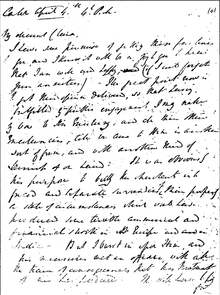Handwriting
The deterioration of a person's handwriting is also a symptom or result of certain diseases.


Uniqueness
Each person has their own unique style of handwriting, whether it is everyday handwriting or their personal signature. Even identical twins who share appearance and genetics don't have the same handwriting. A person's handwriting is like that person's fingerprints: people might be able to copy it, but never write it in an identical way. The place where one grows up and the first language one learns melt together with the different distribution of force and ways of shaping words to create a unique style of handwriting for each person.[2]
Characteristics of handwriting include:
- specific shape of letters, e.g. their roundness or sharpness
- regular or irregular spacing between letters
- the slope of the letters
- the rhythmic repetition of the elements or arrhythmia
- the pressure to the paper
- the average size of letters
- the thickness of letters
Medical conditions
Children with ADHD have been found to be more likely to have less legible handwriting, make more spelling errors, more insertions and/or deletions of letters and more corrections. In children with these difficulties, the letters tend to be larger with wide variability of letters, letter spacing, word spacing, and the alignment of letters on the baseline. Variability of handwriting increases with longer texts. Fluency of the movement is normal, but children with ADHD were more likely to make slower movements during the handwriting task and hold the pen longer in the air between movements, especially when they had to write complex letters, implying that planning the movement may take longer. Children who have ADHD were more likely to have difficulty parameterising movements in a consistent way. This has been explained with motor skill impairment either due to lack of attention or lack of inhibition. To anticipate a change of direction between strokes constant visual attention is essential. With inattention, changes will occur too late, resulting in higher letters and poor alignment of letters on the baseline. The influence of medication on the quality of handwriting is not clear.[3]
Uses of handwriting samples
Because handwriting is relatively stable, a change in the handwriting can be indicative of the nervousness or intoxication of the writer.
A sample of a person's writing can be compared to that of a written document to determine and authenticate the written document's writer; if the writing styles match, it is likely that one person wrote both documents.
Graphology
Graphology is the pseudoscientific[4][5][6] study and analysis of handwriting in relation to human psychology. Graphology is primarily used as a recruiting tool in the applicant screening process for predicting personality traits and job performance, despite research showing consistently negative results for these uses.[7][8][9]
See also
References
- ↑ Huber, Roy A.; Headrick, A.M. (April 1999), Handwriting Identification: Facts and Fundamentals, New York: CRC Press, p. 84, ISBN 0-8493-1285-X
- ↑ Sargur Srihari, Chen Huang and Harish Srinivasan. On the Discriminability of the Handwriting of Twins. J Forensic Sci. 2008 Mar;53(2):430-46. http://www.cedar.buffalo.edu/~srihari/papers/TR-04-07.pdf.Retrieved 25 January 2015
- ↑ M.-L. Kaisera, d, , , M.M. Schoemakerb, J.-M. Albaretc, R.H. Geuze. What is the evidence of impaired motor skills and motor control among children with attention deficit hyperactivity disorder (ADHD)? Systematic review of the literature. Research in Developmental Disabilities. Volume 36, January 2015, Pages 338–357. doi:10.1016/j.ridd.2014.09.023.
- ↑ "Barry Beyerstein Q&A". Ask the Scientists. Scientific American Frontiers. Retrieved 2008-02-22. "they simply interpret the way we form these various features on the page in much the same way ancient oracles interpreted the entrails of oxen or smoke in the air. I.e., it's a kind of magical divination or fortune telling where 'like begets like.'"
- ↑ James, Barry (3 August 1993). "Graphology Is Serious Business in France : You Are What You Write?". New York Times. Retrieved 18 September 2010.
- ↑ Goodwin CJ (2010). Research In Psychology: Methods and Design. John Wiley & Sons. p. 36. ISBN 978-0-470-52278-3.
- ↑ Roy N. King and Derek J. Koehler (2000), "Illusory Correlations in Graphological Inference", Journal of Experimental Psychology: Applied, 6 (4): 336–348, doi:10.1037/1076-898X.6.4.336.
- ↑ Lockowandte, Oskar (1976), "Lockowandte, Oskar Present status of the investigation of handwriting psychology as a diagnostic method", Catalog of Selected Documents in Psychology (6): 4–5.
- ↑ Nevo, B Scientific Aspects Of Graphology: A Handbook Springfield, IL: Thomas: 1986
Further reading
- Giesbrecht, Josh. "How The Ballpoint Pen Killed Cursive". The Atlantic. Retrieved August 28, 2015.
- Kaiser, M.-L.; Schoemaker, M.M.; Albaret, J.-M.; Geuze, R.H. "What is the evidence of impaired motor skills and motor control among children with attention deficit hyperactivity disorder (ADHD)? Systematic review of the literature". Research in Developmental Disabilities. doi:10.1016/j.ridd.2014.09.023. Retrieved January 2015. Check date values in:
|access-date=(help)